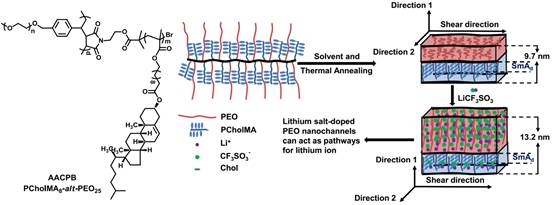| Hierarchically Self-Assembled Amphiphilic Alternating Copolymer Brush Containing Side-Chain Cholesteryl Units |
| From: PublishDate:2017-06-16 Hits: |
Nanomaterials have been intensively researched in recent decades, and they can be used in nanotemplate, photonic crystals, and sensors. Block copolymers (BCPs) are one of the building blocks of nanomaterials. Because the molecular weights (MWs) are limited, BCPs mostly form ordered nanostructures in the range of 10-100 nm. Recently, brush block copolymers can form ordered nanostructures with over-100 nm length sizes. However, it is quite challenging to obtain ordered nanostructures on the sub-10 nm length scale. A research group from the Department of Polymer Science and Engineering in the College of Chemistry and Molecular Engineering at Peking University has constructed an ordered nanostructure of 9.66 nm by using amphiphilic alternating copolymer brush (AACPB) containing side-chain cholesteryl units. Their research has been published in Macromolecules on August 11, 2016. The group synthesized the AACPB containing cholesteryl-based side-chain liquid crystalline polymer (LCP) and poly(ethylene oxide) (PEO) (Figure 1) with the “grafting through” strategy to ensure the precisely defined chemical structures. The cholesteryl units in the AACPBs can form a double-layer smectic A (SmAd) LC phase of 5.46 nm, which will offer the additional Flory-Huggins interaction parameter (c) to drive the microphase separation between the LCP and PEO side chains. As a result, the whole polymer brush self-assembles into lamellar nanostructure of 9.66 nm. The SmAd LC phase and the lamellar nanostructure constructs a hierarchically ordered structure (Figure 1), which is determined by using synchrotron radiation at Beijing Synchrotron Radiation Facility (BSRF). The polymer brush may be used in the area of nanotemplates on the sub-10 nm length scale.
Figure 1. Chemical structure of the AACPB and the hierarchically ordered structures of the neat and lithium salt-doped AACPB: the microphase-separated lamellar nanostructure and the SmAd LC phase formed by cholesteryl mesogens After doping 0.2 eq lithium salt LiCF3SO3, the complex also forms a lamellar nanostructure, the d-spacing (13.2 nm) of which is larger than that (9.7 nm) of the lamellar nanostructure formed by the neat AACPB because the interaction between lithium ion and oxygen atom makes the PEO side chains stretched (Figure b). The AACPB/LiCF3SO3 complex can transport lithium ion. However, its ionic conductivity at ambient temperature is pretty low (5.42×10-8 S/cm). With increasing PEO content, the ionic conductivity can be improved, and the complex may be used as solid polymer electrolytes in lithium ion battery. In the work, synchrotron radiation at BSRF plays a vitally important role in resolving the hierarchically ordered structures of the abovementioned AACPB and its complexes. Prof. Xinghe Fan and Prof. Zhihao Shen in the Department of Polymer Science and Engineering of the College of Chemistry and Molecular Engineering at Peking University believe that this work may open a new avenue for preparing polymer materials with hierarchically ordered sub-10 nm structures and solid polymer electrolytes in lithium ion battery. Article: Jing Ping, Kehua Gu, Sheng Zhou, Hongbing Pan, Zhihao Shen*, and Xing-He Fan* Hierarchically Self-Assembled Amphiphilic Alternating Copolymer Brush Containing Side-Chain Cholesteryl Units. Macromolecules 49(2016), 5993–6000. |
|
|
| Chinese
- Metal-free efficient photocatalyst for stable visible water splitting——Top ten major scientific progresses in China in 2015
- The nano-resolution imaging platform was awarded the first rate prize of Beijing Science and Technology in 2014
- Beamline 1W1 of BSRF started to runoperate in the couplingparasitic mode of BEPCII
- Synthesis of High Performance Polymer Materials for Field Effect-Transistors
- Surfactant molecular aggregates in green solvents
- GIXRD has played an important role in the characterization of organic thin-film transistors
Copyright © 2011 - 2012 Beijing Synchrotron Radiation Facility


